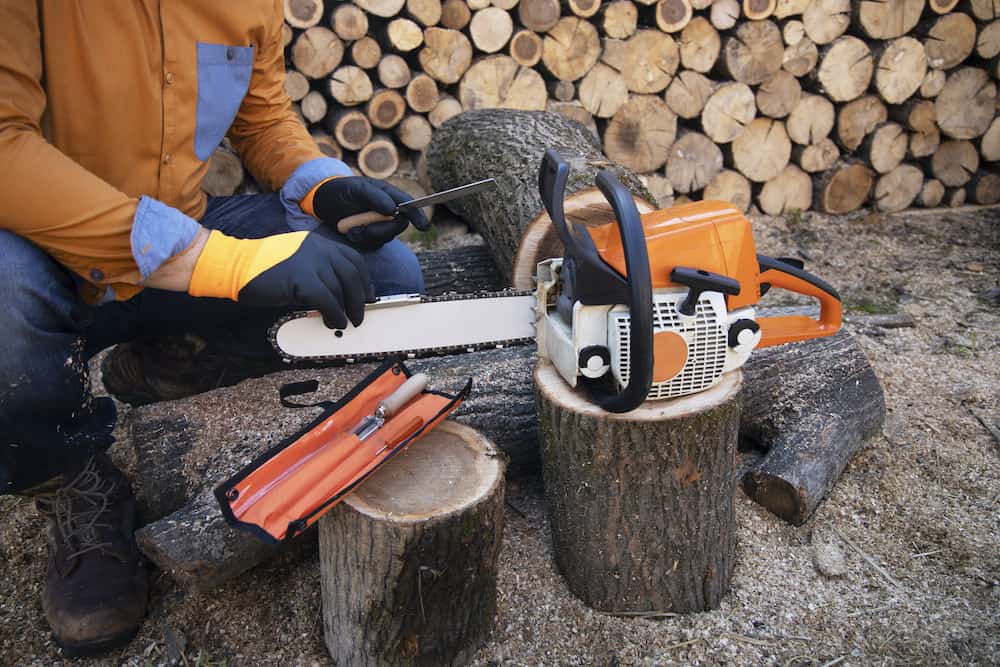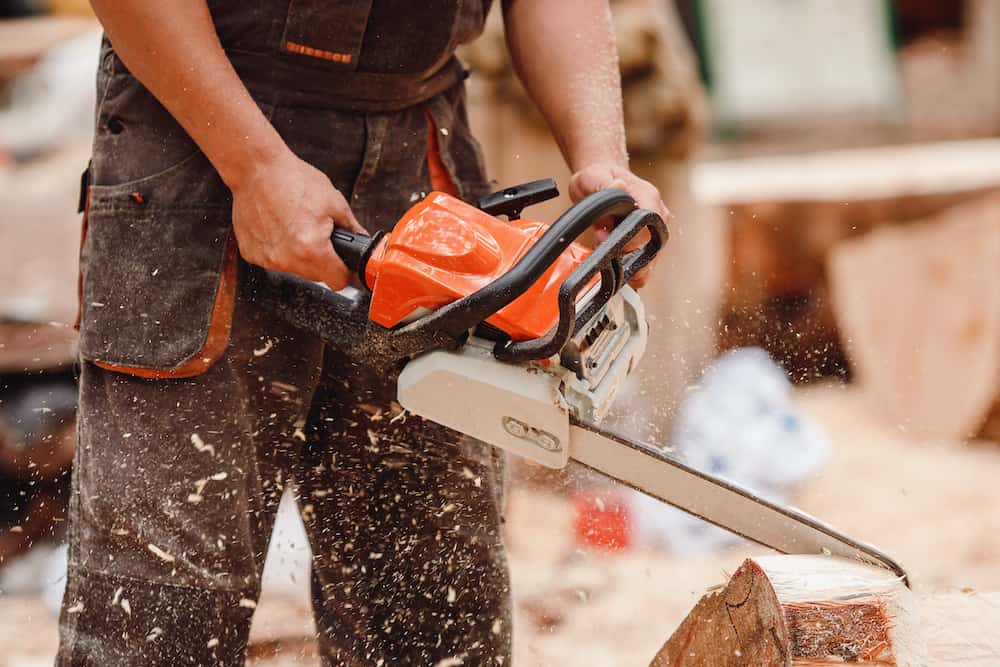Before using a chainsaw, it’s good to ask, “What size chainsaw do I need?” especially with the many available designs. Unless you’ve owned a chainsaw in the past, it can seem overwhelming to find a right-sized model. You want it to be robust and powerful enough for what you want it it do. At the same time, you want to feel comfortable handling it. Safety is paramount.
You’ll need to know the cutting bar is long enough to cut through thick logs and branches. With the tips in this guide, you’ll quickly size your chainsaw for any project.
What Size Chainsaw Do I Need
When most people refer to the size of their chainsaw, they mean the cutting bar. The bar is the part of the tool that holds the chain and allows you to cut effortlessly through materials. Cutting bars tend to range in size from 6 – 20 inches. They go larger for professional, commercial chainsaws. The higher the number, the larger the saw, and the more robust.
A six inch chainsaw will likely be electric. This is a small electric chainsaw. The larger, personal home use chainsaws with 20 inch bars are typically gasoline-powered models.
When determining chainsaw sizes, you need to consider what you want to cut with it. Will you be felling trees and bucking? Or will you so more smaller-scale limbing and pruning and other property maintenance grooming?
How Big of a Tree Can a 16 Chainsaw Cut?
In general, most professionals recommend sizing up by two inches when choosing a bar length. This means when considering how big of a tree can a 16 chainsaw cut, you can cut a trunk with a width of up to 14 inches.
Consider:
- 20 chainsaw would cut through an 18″ tree diameter
- 16 chainsaw would cut through a 14″ tree diameter
- 10 inch chainsaw for 8″ in diameter
- 6 inch chainsaw can cut a 4″ diameter
You can guarantee you’ll always have enough space for cutting without overwhelming the chain by sizing up.
How Do I Choose a Chainsaw Chain Size?
Once you start shopping for a chainsaw, it’s essential to know how what to look for. Manufacturers make the process simple since the bar’s length is typically printed on one side of the blade.
Also, it should be one of the most recognizable specifications on websites and in-store displays. If you’re curious about your existing model, you can measure the bar’s length or consult its manual. You may also consider borrowing a chainsaw from a neighbor. You’ll need to measure what you want to cut so you’ll know the correct size to borrow.
Measure Chainsaw Bar
Determining the length when asking, “What size chainsaw do I need?” is simple, as long as you have a tape measure. Using the tape measure, you’ll want to calculate the length from the bar’s furthest tip to the blade’s base.
Make sure you get as close to the engine housing as possible for the most accurate measurements. You might find that the measurements give you an odd length, and you can round it to the nearest even number. It’s important to note that chainsaw bars are sold in even lengths, like 14″ and 16″.
Think About Daily Tasks
The second step to figuring out the perfect chainsaw size for your property is to think about the work you typically do. If you’re responsible for light chores, you’ll need a smaller model. This will be one smaller than 16 inches. These are ideal for occasional light cutting, trimming, and pruning bushes, etc.
If you want a general, all-purpose chainsaw that you can use to cut through thick branches and tree logs, you should chainsaw sizes between 16 and 18 inches.
Alternatively, rural properties can often be better suited with a heavy-duty and larger chainsaw. If you imagine you will use the chainsaw to clear a lot of trees and brush, you may need a heavy-duty model. In this case, consider a 20 inch chainsaw.
Larger than 20 and the chainsaw can become difficult to use. It will be heavy and challenging to manage. You never want to compromise safety. This means, don’t be tempted to get a very large model just because it looks like it can handle everything.
You’ll find that smaller and more detailed work will be very difficult with a huge model. On the other hand, too small of a chainsaw won’t allow you to tackle larger projects without wasting your time.
Here are the recommended chainsaw sizes for specific tasks:
Pruning Limbs
As the most light-duty projects on this list, pruning limbs around your yard shouldn’t take too much power or length. The majority of limbs are no larger than eight inches, so you should need a 6 – 10 inch chainsaw blade. As long as you know the proper pruning techniques, using smaller chainsaws will be a breeze.
Branch Removal
As a step up, removing branches will need a little more length because they have a greater circumference than limbs. You might find that your 10 inch chainsaw is too small for the task, so we recommend an 8 – 12 inch blade or bar. Since branches can be unusually thick, larger blades can be easier to wield and more efficient cutters.
Small Trees
Again, you will want to take the tree trunk’s thickness into account to decide if a smaller chainsaw will work. In most cases, you should be looking at a 12-inch chainsaw at the minimum, often considering 14-inch models.
Large Trees
Cutting down trees is an incredibly heavy-duty project, and you’ll need the right equipment for the task. Whether you’re restoring your backyard or managing overgrowth at a commercial property, they’re ideal. Not only will you need to make sure you have a longer blade, but also a more powerful motor. The minimum blade length for this task could be 20 inches or more, depending on how you can safely cut down the tree.
Consider Your Experience
Not only does your chainsaw bar’s size determine the extent of wood you can cut, but it also relates to control. The longer the bar is, the more challenging it will be to control, mostly if you have limited experience with power tools.
Using a chainsaw can be particularly dangerous, and leaving tree removal to the professionals is preferable. Long bars tend to have exceptional kickback, which needs to be predicted and expected.
You might have to apply more pressure than usual to ensure the teeth cut into the wood seamlessly. You’ll also find that long bars are harder to hold for extended periods.
If you intend to tackle large trees on your property, we recommend finding a chainsaw with low-kickback. This feature should allow you to maintain adequate control over the tool to keep you safe.
If you’re concerned about your experience level, learn all you can about how to start a chainsaw and all about safety precautions.
Consider Your Physical Strength
Although this isn’t the most crucial part of measuring your chainsaw, it’s important to consider. When you’re wielding a chainsaw, you’ll be relying on nothing other than your physical power.
With that said, you won’t want a unit that is too challenging to handle for extended periods. That is why more homeowners prefer electric chainsaws over gas ones. Electric chainsaws require far fewer parts and are significantly more lightweight than gas. Even though gas-powered units can have more cutting power, they can make you tired in far less time.
What Is the Best Size Chainsaw for Cutting Firewood?
As one of the most popular tasks you might want a chainsaw for, there are recommendations for firewood. Like any other project, you will want to think about the average width of the stumps you’ll work with.
Fortunately, using a chainsaw is more comfortable than a wood axe, and you won’t need a giant tool for the job. On average, you’ll get fair use out of a 12 – 16 inch chainsaw for firewood.

Can You Customize Your Chainsaw?
With most name brand chainsaws, you can make bar adjustments to increase the saw’s versatility. Instead of needing a new chainsaw for large, small, and medium trees, you might have all three sizes in one. It’s important to confirm whether your specific model will allow for bar substitutions before making the change. Typically, this information can be found in your owner’s manual or on the manufacturer’s website.
Can I Put a Shorter Bar on My Chainsaw?
The majority of chainsaws allow for up to three different bar sizes, but the accurate sizes will vary based on the company. Some models can allow sizes from 14 to 40 inches, while others have smaller ranges.
With that said, changing the bar isn’t as easy as swapping one piece for another, and you must consider:
1. Oiler Nipple
The oiler nipple’s primary job is to make sure the bar is regularly oiled while you’re cutting. This piece is particularly vital in chainsaws with automatic oilers.
When you’re replacing the bar, you must make sure it’s the right size to align with the oiler nipple. On the bottom of your new blade, it should give you the pitch size and guard slots. You should then be able to tell whether a specific bar would fit perfectly into your existing housing.
2. Chain
When you change the chainsaw’s bar, you also need to change the chain; otherwise, it won’t fit. You’ll need to make sure the chain fits the diameter of the new bar snugly.
It’s also essential to ensure the guide links fit into the new guide slots. If the guide links are too small, the chain will fall off, and if they’re too large, there will be too much pressure.
Extra pressure on your chain can cause it to snap when rotating at dangerous speeds. Fortunately, finding the perfectly sized chain is very simple with the right measurements. You will want to ensure the pitch measurement is identical to your new bar to avoid hazardous conditions.
3. Sprocket
When changing your bar, the final part to consider is the sprocket, where the chain’s drive links go. On the drive sprocket, there are precise grooves where the links slide in. The sprocket is close to the clutch, and its job is to power the chain using the engine. With a fully functioning chainsaw, the chain will glide around the sprocket without any hiccups.
Similar to the chain, you’ll have to pay close attention to the chain links. Improperly sized chain links can cause the sprocket to grind down, or you could snap the chain. Making impromptu upgrades to your chainsaw can be dangerous if the process isn’t handled correctly.
It’s always essential you follow the precise instructions and recommendations in your owner’s manual. Otherwise, you could be risking your life and limbs.
If you’re not comfortable with making the changes yourself, rely on the professionals. A specialist will ensure the bar is changed effortlessly while protecting the crankshaft, clutch, and chain.
What Size Chainsaw Do I Need?
As long as you have a good idea of the task ahead of you, sizing your chainsaw is easy using the two-inch rule. With the perfect size, you can quickly transform your property into a captivating homestead. By following the tips in this guide, you should find the perfect solution to chainsaw sizes. Whether you borrow one from a friend or neighbor, or decide to buy a chainsaw, read the instruction manual thoroughly to help ensure your safety. Read recommendations for the best electric chainsaw.
Related articles

